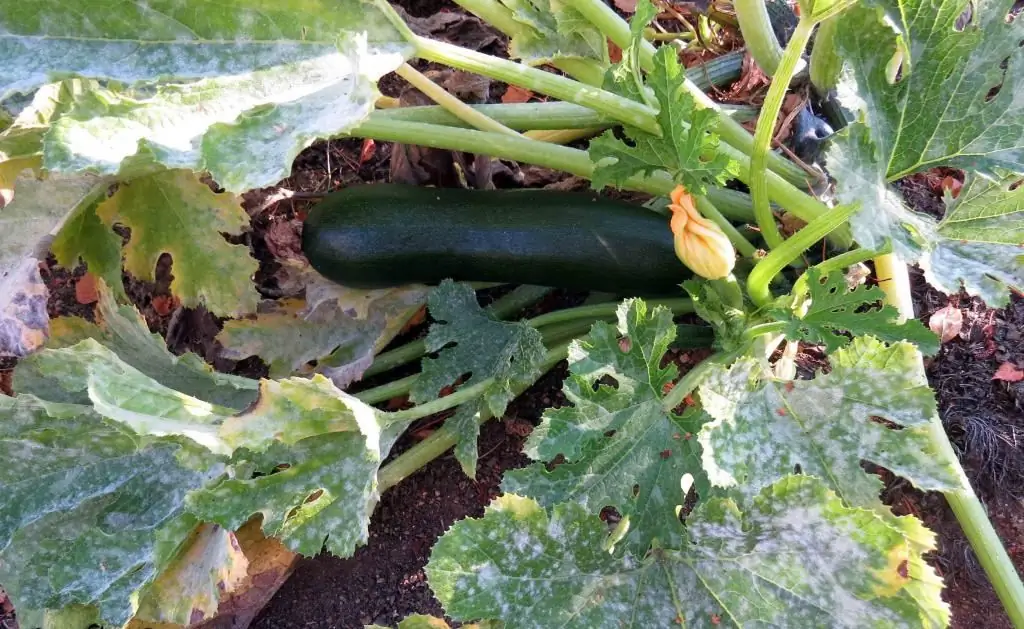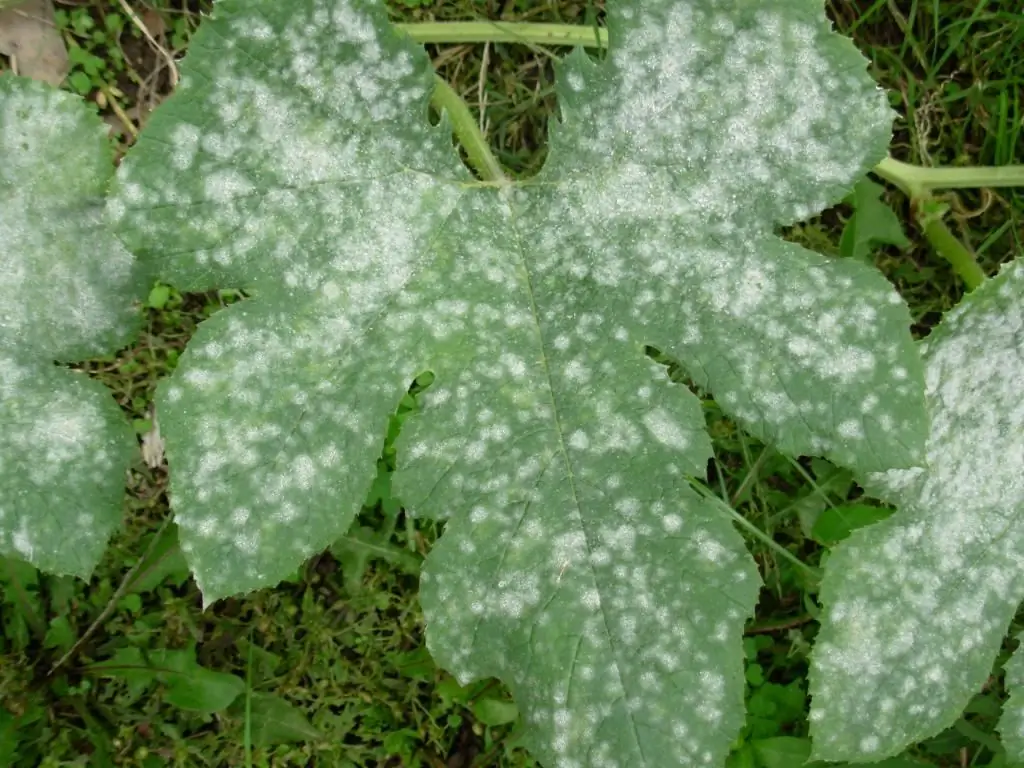Powdery mildew is also called linen or ashtray. This disease in plants is caused by microscopic fungi belonging to the category of erysiphous or powdery mildew, living in the soil. This article is about how to properly treat powdery mildew in some plant species.
Symptoms
Many plants are susceptible to this disease, including roses, cereals and cucurbits, peach, grapes, gooseberries, sugar beet, some trees, house and garden flowers. However, in the presence of the same symptoms, each of them has a different pathogen. Take, for example, American powdery mildew, which affects roses, gooseberries, and peaches. It can be called by three different sphere libraries at once.

The first symptom of a plant disease is the appearance of a light mycelium coating on them with drops of moisture. First, those shoots and leaves that are closest to the ground are infected. If treatment is not started on time, the disease will progress and, in the end, will cover the entire plant. If you look closely, you can seeon the areas affected by the fungus, tiny sores, from which the green plantation begins to lose its attractiveness, since nutrition does not reach it, and the leaves covered with bloom stop the process of photosynthesis.
Causes of disease
Fungi are activated under the following climatic conditions:
- with frequent temperature changes;
- with an increased level of nitrogen in the earth;
- if it rains too often;
- at a temperature of +15…+30 ⁰C and air humidity over 60%;
- after anti-aging pruning;
- with irregular watering, i.e. when the soil either dries out often or is too wet.
Treatment of indoor plants
Home flowers are also prone to fungal diseases. If a white coating appears on the leaves, it is necessary to immediately treat them with a fungicide, as well as the soil and walls of the pot where they grow. For this purpose, drugs such as Thiovit Jet, Bayleton, Topaz, Hom, Vitaros, Fundazol, Skor and Vectra are suitable. What to do when time is running out? In this case, you need to remove the top layer of soil from the pot, where the fungal mycelium colonies settled, and change it to a new, disinfected substrate.

Most often, powdery mildew appears on houseplants such as saintpaulia, cissus, kalanchoe, rose, begonia and gerbera. The cause of the disease is dry soil, moist stale air and temperature differences. Fungusis transferred from a diseased plant to a he althy one when the pots are very close, with the help of insects or air currents. To prevent this disease, you need to periodically feed the soil with potassium-phosphorus fertilizers, as well as monitor plant hygiene, water balance and ventilate the premises more often.
Treatment of vegetable crops
Powdery mildew on cucumbers can be de alt with using chemicals or folk remedies. Do not forget that regardless of the method of struggle, it is necessary to remove all affected parts of the plant. You can sprinkle cucumbers with sulfur powder (25 g per 10 m²). Spraying the plant with mullein helps well.
Another effective way to fight the fungus is a solution of colloidal sulfur (no more than 30 g of the substance per bucket of water). If you decide to get rid of the disease with fungicides, then it is best to use the most effective of them, such as Oxyhom or Topaz.

Preparations for parasite control
Powdery mildew in plants is treated with the help of chemicals, which are such fundicides as Bayleton, Topsin-M, Fundazol, Skor, Previkur, Vectra, Thiovit Jet ", "Hom", "Tsineb", "Vitaros", "Switch", "Kuprozan", "Ftalan", "Fitosporin-M", "Kvadris". Colloidal sulfur, copper sulphate, Bordeaux liquid, copper oxychloride, etc. have proven themselves well.
All these drugs can only be bought at specialized outlets. Apply fungicides only according to the instructions.

Treatment with folk remedies
Getting rid of the fungus on plants is possible not only with the help of drugs. There are many effective ways to defeat powdery mildew, while using only folk remedies. Here are some of them:
- Garlic infusion. Crushed shoots and cloves of a plant weighing 50 g are poured into 2 liters of water. Insist for two days, then filter. The infusion is used undiluted.
- Mustard solution. They are watered or sprayed on plants. To prepare it, you need to take 2 tbsp. l. mustard powder and dilute it in 10 liters of slightly warmed water.
- Kefir solution. In 10 liters of water, stir 1 liter of yogurt or fermented kefir. With the resulting solution, it is necessary to process the plant three times, making an interval of several days.
- Ash solution. It is prepared from 10 liters of water, where no more than 1 kg of wood ash is mixed in, insisted for seven days. Then drain and add 20 g of grated or liquid soap. The resulting solution is sprayed on plants at intervals of one day.
Downy mildew description
The scientific name for this disease is peronosporosis. Most often, it affects cucumbers and other plants related to it: watermelons, pumpkins, zucchini and melons. It is not difficult to identify infected greens, as yellow and brown spots appear on it immediately.
Plantcan become infected at any stage of development and regardless of where it is located: on open ground or in a greenhouse. Although the fungus does not affect the fruits, dried leaves and lashes of the plant lead to a decrease in yield. In addition, the vegetables will be inconspicuous in appearance and completely tasteless.

Ways to fight
The worst thing is that the fungus infects the seeds of plants, but this can and should be fought. The most effective way is to process them before planting in the ground. For this, the drug "Trichomerdin" is perfect. Use it strictly according to the instructions, otherwise an overdose will lead to deformation of the seeds, and later to a slowdown in the growth of the plant itself. The Trichomerdin paste, which contains 40% of the main substance, has also proven itself well. It is used only on sections of affected stems and leaves.
Sprinkling will also help rid plants of a fungal disease. For this procedure, the drug "Planriz" is used, which includes herbs that prevent further infection. Emergency treatment of plants is also carried out with combined fungicides. These include copper oxychloride, Ridomil Gold and Efal. These preparations are best suited for use in greenhouses, and on open ground, experts recommend spraying with Acrobat MC as soon as 3-5 leaves appear on young plants.






